1997 PONTIAC PONTIAC check engine
[x] Cancel search: check enginePage 218 of 419
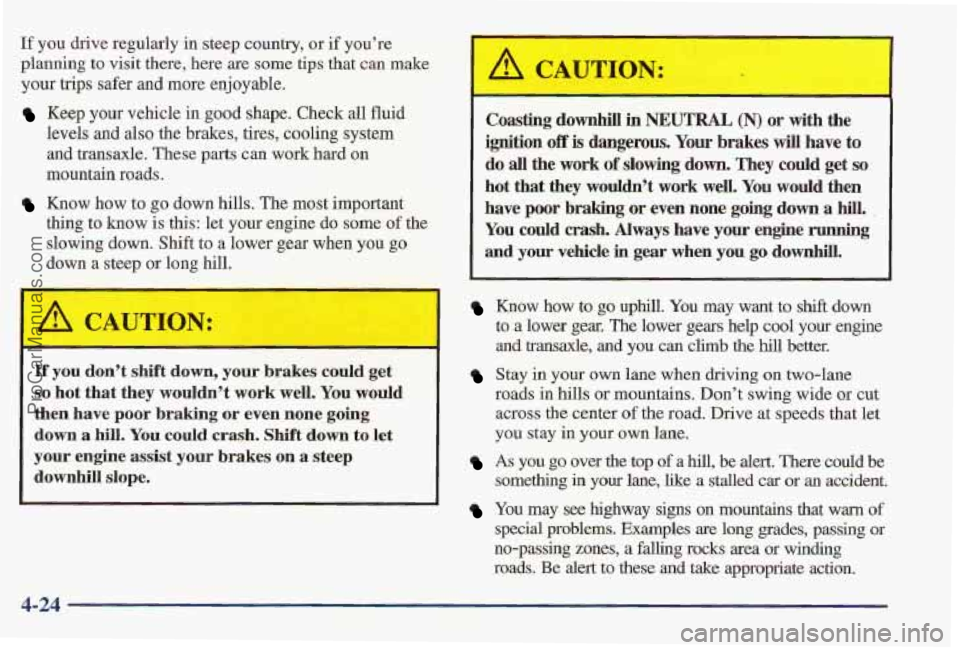
If you drive regularly in steep country, or if you’re
planning
to visit there, here are some tips that can make
your
trips safer and more enjoyable.
Keep your vehicle in good shape. Check all fluid
levels
and also the brakes, tires, cooling system
and transaxle. These
parts can work hard on
mountain roads.
Know how to go down hills. The most important
thing
to know is this: let your engine do some of the
slowing down. Shift to
a lower gear when you go
down
a steep or long hill.
If you don’t shift down, your brakes could get
so hot that they wouldn’t work well. You would
then have poor braking or even none going
down
a hill. You could crash. Shift down to let
your engine assist your brakes
OIJ a,qteep
downhill slope. I ,. +;‘ . ..
<,r:. ,. . I .’ I ; ..:, .h.=;. 2-l:.
.. . .,
I
Coasting downhill in NEUTRAL (N) or with the
ignition off is dangerous. Your brakes will have to
do all the work of slowing down. They could get so
hot that they wouldn’t work well. You would then
have poor
braking or even none going down a hill. ,
You could crash. Always have your engine running
and your vehicle in gear when you go downhill.
I
Know how to go uphill. You may want to shift down
to a lower gear. The lower gears help cool your engine
and transaxle, and
you can climb the hill better.
Stay in your own lane when driving on two-lane
roads
in hills or mountains. Don’t swing wide or cut
across the center
of the road. Drive at speeds that let
you stay in your own lane.
As you go over the top of a hill, be alert, There could be
something in your lane, like a stalled car or an acci’dent.
You may see highway signs on mountain,s that warn of
special problems. Examples are long grades, passing or
no-passing zones,
a falling rocks area or winding
roads.
Be alert to these and take appropriate action.
4-24
ProCarManuals.com
Page 222 of 419
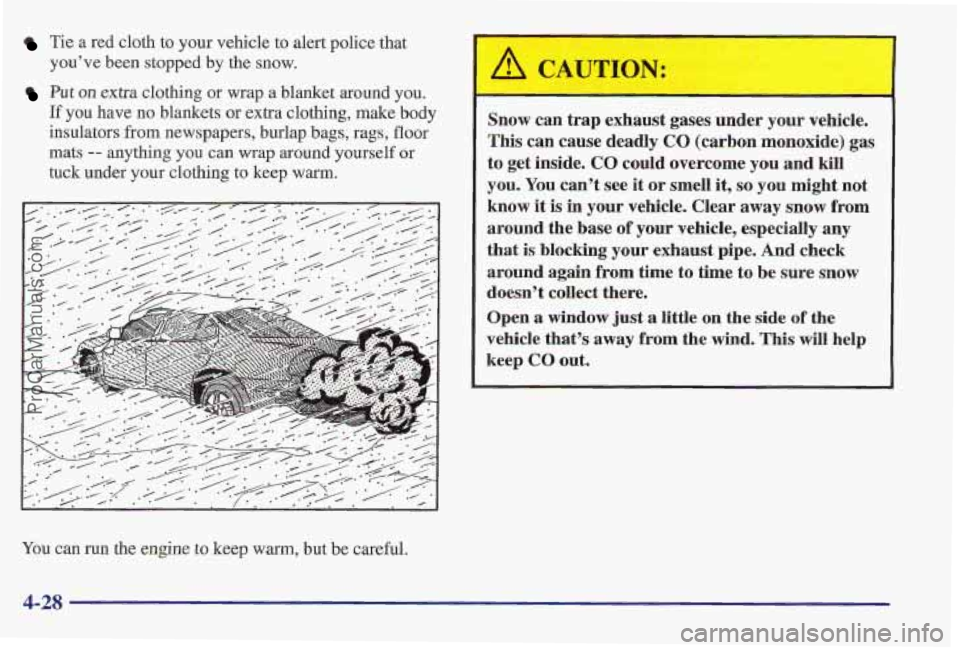
Tie a sed cloth to your vehicle to alert police that
you've been stopped
by the snow.
Put on extra clothing or wrap a blanket 'aro'und you.
If you have no blankets or extra clothing, make body
insulators from newspapers, burlap bags, rags, floor
mats
-- anything you can wrap around yourself or
tuck under your clothing to keep
warm.
Snow can trap exhaust gases under your vehicle.
This can cause deadly
GO (carbon monoxide) gas
to get inside.
GO could overcome you and kill
you. You can't see it or smell
it, so you might not
know
it is in your vehicle. Clear away snow from
around the
base of your vehicle, especially any
that is blocking
your exhaust pipe. And check
around
again from time to time to be sure snow
doesn't collect there.
Open
a window just a little on the side of the
vehicle that's away from the wind. This will help
keep
CO out.
i
You can run the engine to keep warm, but be careful,
4-28
ProCarManuals.com
Page 231 of 419

Making Turns
I NOTICE:
Making very sharp turns while trailering could cause the trailer to come in contact with the
vehicle. Your vehicle could be damaged. Avoid making very sharp turns while trailering.
When you’re turning with a trailer, make wider turns than
normal.
Do this so your trailer won’t strike soft shoulders,
curbs, road signs, trees or other objects. Avoid jerky or
sudden maneuvers. Signal well in advance.
Turn Signals When Towing a Trailer
When you tow a trailer, your vehicle may need a
different turn signal flasher andlor extra wiring. Check
with your Pontiac dealer. The green arrows on your
instrument panel will flash whenever you signal a turn
or lane change. Properly hooked up, the trailer lamps
will also flash, telling other drivers you’re about to turn,
change lanes or stop. When towing
a trailer, the green
arrows on your
instrument panel will flash for turns even if the bulbs on
the trailer are burned out. Thus, you may think drivers
behind you are seeing your signal when they are not. It’s
important to check occasionally to be
sure the trailer
bulbs
are still working.
Your vehicle has bulb warning lights. When you plug
a
trailer lighting system into your vehicle’s lighting
system, its bulb warning lights may not
let you know if
one of your lamps goes out. So, when you have a trailer
lighting system plugged in, be sure to check your
vehicle and trailer lamps
from time to time to be sure
they’re all working. Once you disconnect the trailer
lamps, the bulb warning lights again can tell you if one
of your vehicle lamps is out.
Driving On Grades
Reduce speed and shift to a lower gear before you start
down a long or steep downgrade. If you don’t shift
down, you might have to use your brakes
so much that
they would get hot and no longer work well.
On
a long uphill grade, shift down and reduce your
speed to around
45 mph (70 kd) to reduce the
possibility
of engine and transaxle overheating.
If you have Overdrive, you may want to drive in
THIRD (3), instead of DRIVE (D),
4-37
ProCarManuals.com
Page 232 of 419

Parking on Hills
You really should not park your vehicle, with a trailer
attached,
on a hill. If something goes wrong, your rig
could start to move. People
can be injured, and both
your vehicle and the trailer can be damaged.
But
if you ever have to park your rig on a hill, here’s
how to do it:
1. Apply your regular brakes, but don’t shift into
2. Have someone place chocks under the trailer wheels.
3. When the wheel chocks are in place, release the
regular brakes until the chocks absorb the load.
4. Reapply the regular brakes. Then apply your parking
brake, and then shift to
FARM (P).
5. Release the regular brakes.
PARK (P) yet,
When You Are Ready to Leave After
Parking on a Hill
1. Apply your regular brakes and hold the pedal down
while you:
Start your engine;
Shift into a gear; and
0 Release the parking brake.
2. Let up on the brake pedal.
3. Drive slowly until the trailer is clear of the chocks.
4. Stop and have someone pick up and store the chocks.
Maintenance When Trailer Towing
Your vehicle will need service more often when you’re
pulling
a trailer. See the Maintenance Schedule for more
on this. Things that are especially important in trailer
operation are automatic transaxle fluid (don’t overfill),
engine oil, belts, belt, cooling system and brake
adjustment. Each
of these is covered in this manual, and
the Index will
help you find them quickly. If you’re
trailering, it’s a good idea to review these sections
before you start your trip.
Check periodically to see that all hitch nuts and bolts
are tight.
4-38
ProCarManuals.com
Page 239 of 419

Using a match near a battery can cause battery
gas
to explode. People have been hurt doing this,
and some have been blinded. Use
a flashlight if
you need more light.
Be sure the battery has enough water. You don’t
need to add water to the Delco Freedom@ battery
installed in every new
GM vehicle. But if a
battery has filler caps, be sure the right amount
of fluid is there. If it is low, add water to take
care of that first. If you don’t, explosive gas
could be present.
Battery fluid contains acid that can burn you.
Don’t get
it on you. If you accidentally get it in
your eyes or on your skin, flush the place with
water and get medical help immediately.
5. Check that the jumper cables don’t have loose or
missing insulation. If they do, you could get a shock,
The vehicles could be damaged, too.
Before you connect the cables, here are some basic
things you should know. Positive (+) will go to
positive (+) and negative (-) will go to negative (-)
or a metal engine part. Don’t connect positive (+) to
negative
(-), or you’ll get a short that would damage
the battery and maybe other parts, too.
Fans or other moving engine parts can injure you
badly. Keep
your hands away from moving parts
5-5
ProCarManuals.com
Page 250 of 419
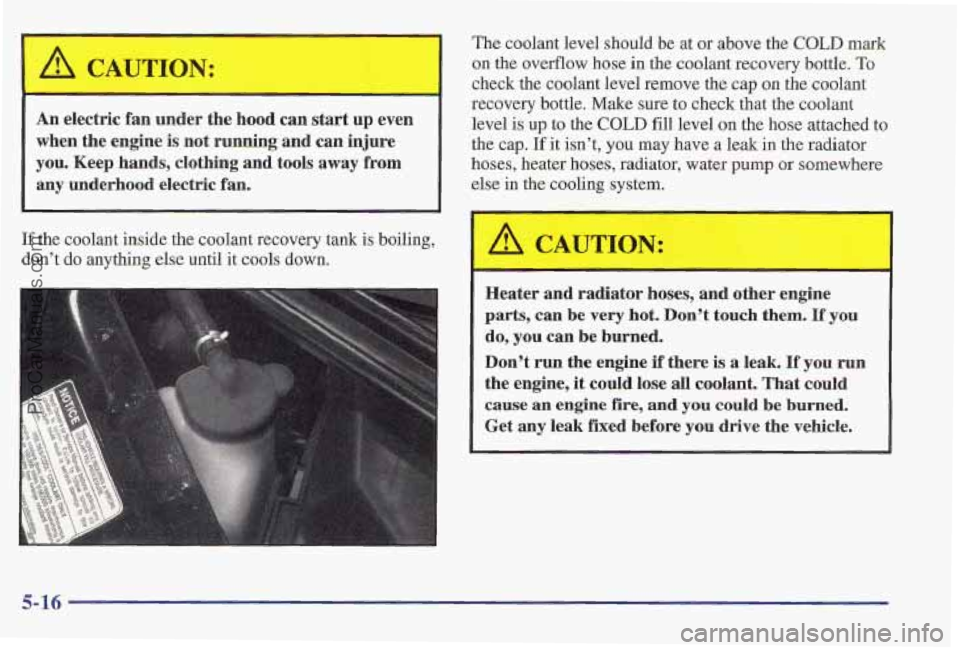
I
An electric fan under the hood can start up even
when the engine is not running and can injure
you. Keep hands, clothing
and tools away from
any underhood electric fan.
If the coolant inside the coolant recovery tank is boiling,
don’t
do anything else until it cools down.
The coolant level should be at or above the COLD mark
on the overflow hose in the coolant recovery bottle. To
check the coolant level remove the cap on the coolant
recovery bottle. Make sure to check that the coolant
level is up to the
COLD fill level on the hose attached to
the cap.
If it isn’t, you may have a leak in the radiator
hoses, heater hoses, radiator, water
pump or somewhere
else in the cooling system.
Heater and radiator hoses, a i other engine
parts, can
be very hot. Don’t touch them. If you
do, you can be burned.
Don’t run the engine if there is a leak. If you run
the engine,
it could lose all coolant. That could
cause
an engine fire, and you could be burned.
Get any leak fixed before you drive the vehicle.
5-16
ProCarManuals.com
Page 251 of 419
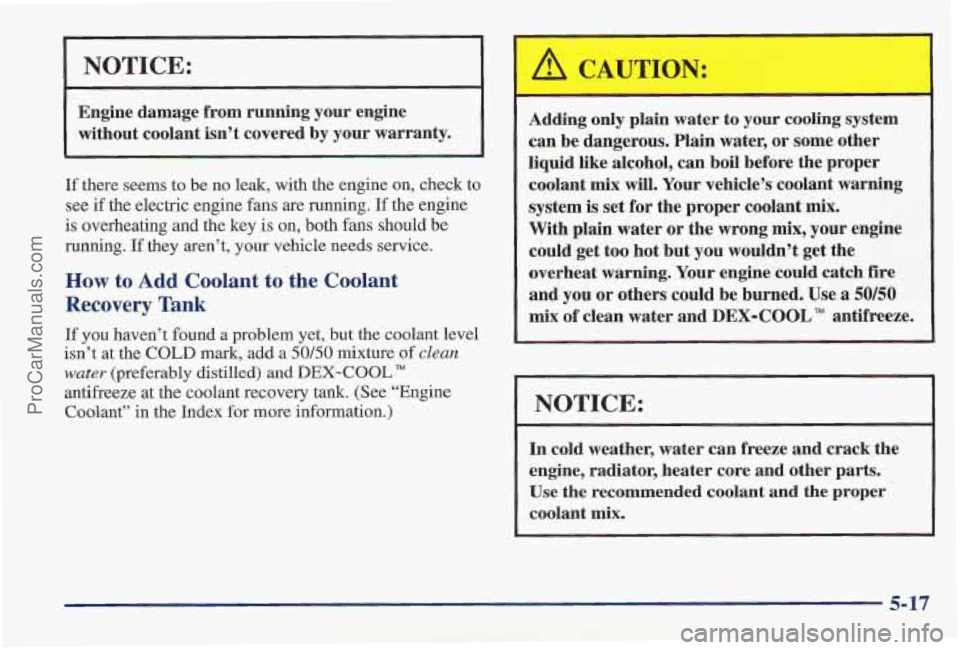
NOTICE:
Engine damage from running your engine
without coolant isn’t covered
by your warranty.
_I
If there seems to be no leak, with the engine on, check to
see if the electric engine fans are running.
If the engine
is overheating and the key
is on, both fans should be
running. If they aren’t, your vehicle needs service.
How to Add Coolant to the Coolant
Recovery Tank
If you haven’t found a problem yet, but the coolant level
isn’t at the
COLD mark, add a 50/50 mixture of clean
water (preferably distilled) and DEX-COOL
antifreeze at the coolant recovery tank. (See “Engine
Coolant” in the Index for more information.)
Adding only plain water to your cooling system
can be dangerous. Plain water, or some other
liquid like alcohol, can boil before the proper
coolant mix will. Your vehicle’s coolant warning
system is set for the proper coolant
mix.
With plain water or the wrong mix, your engine
could get too hot but you wouldn’t get the
overheat warning. Your engine could catch
fire
and you or others could be burned. Use a 50/50
mix of clean water and DEX-COOL antifreeze.
I NOTICE:
In cold weather, water can freeze and crack the
engine, radiator, heater core and other parts.
Use the recommended coolant and the proper
coolant mix.
ProCarManuals.com
Page 257 of 419
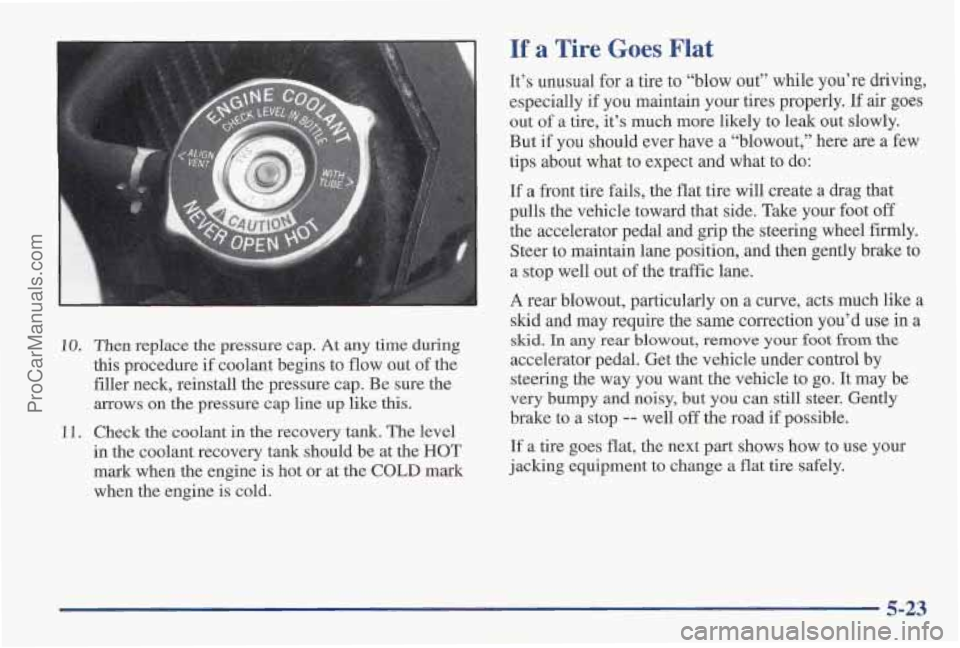
If a Tire Goes Flat
10. Then replace the pressure cap. At any time during
this procedure if coolant begins to flow out
of the
filler neck, reinstall the pressure cap. Be sure the
mows
on the pressure cap line up like this.
11. Check the coolant in the recovery tank. The level
in the coolant recovery tank should be at the HOT
mark when the engine is
hot or at the COLD mark
when the engine is cold. It’s unusual for
a tire to “blow out”
while you’re driving,
especially
if you maintain your tires properly. If air goes
out of a tire, it’s much more likely to leak out slowly.
But if you should ever have a “blowout,” here are a few
tips about what to expect and what to do:
If
a front tire fails, the flat tire will create a drag that
pulls the vehicle toward that side. Take your foot
off
the accelerator pedal and grip the steering wheel firmly.
Steer to maintain lane position, and then gently brake to
a stop well out
of the traffic lane.
A rear blowout, particularly on a curve, acts much like a
slud and may require the same correction you’d use in a
skid. In any rear blowout, remove your foot from the
accelerator pedal. Get the vehicle under control by
steering the way you want the vehicle to go. It may be
very bumpy and
noisy, but you can still steer. Gently
brake to a stop
-- well off the road if possible.
If a tire goes flat, the next part shows how to use your
jacking equipment to change a
flat tire safely.
ProCarManuals.com